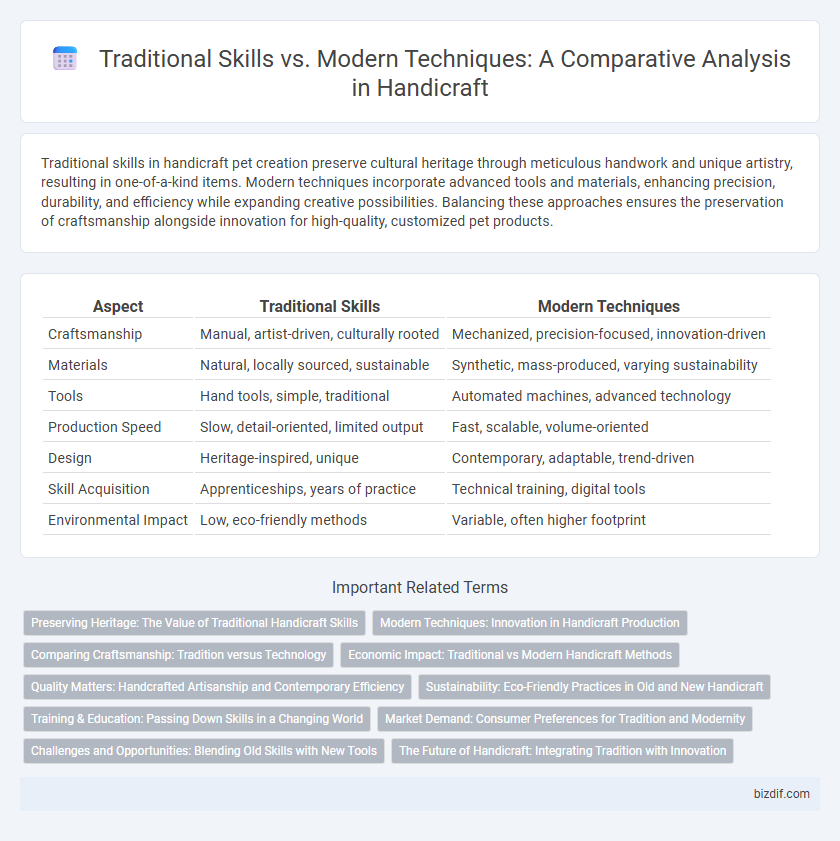Traditional skills in handicraft pet creation preserve cultural heritage through meticulous handwork and unique artistry, resulting in one-of-a-kind items. Modern techniques incorporate advanced tools and materials, enhancing precision, durability, and efficiency while expanding creative possibilities. Balancing these approaches ensures the preservation of craftsmanship alongside innovation for high-quality, customized pet products.
Table of Comparison
| Aspect | Traditional Skills | Modern Techniques |
|---|---|---|
| Craftsmanship | Manual, artist-driven, culturally rooted | Mechanized, precision-focused, innovation-driven |
| Materials | Natural, locally sourced, sustainable | Synthetic, mass-produced, varying sustainability |
| Tools | Hand tools, simple, traditional | Automated machines, advanced technology |
| Production Speed | Slow, detail-oriented, limited output | Fast, scalable, volume-oriented |
| Design | Heritage-inspired, unique | Contemporary, adaptable, trend-driven |
| Skill Acquisition | Apprenticeships, years of practice | Technical training, digital tools |
| Environmental Impact | Low, eco-friendly methods | Variable, often higher footprint |
Preserving Heritage: The Value of Traditional Handicraft Skills
Traditional handicraft skills embody centuries of cultural heritage, preserving techniques passed down through generations that modern methods often overlook. These artisanal practices maintain authenticity and unique craftsmanship, contributing significantly to cultural identity and community sustainability. Integrating traditional skills with selective modern techniques enhances productivity while safeguarding the essence of heritage craftsmanship.
Modern Techniques: Innovation in Handicraft Production
Modern techniques in handicraft production integrate digital tools such as 3D printing, laser cutting, and computer-aided design (CAD), enhancing precision and efficiency. These innovations enable artisans to scale production while maintaining intricate details traditionally achieved by hand. The fusion of technology with craftsmanship creates new market opportunities and preserves cultural heritage through adaptive techniques.
Comparing Craftsmanship: Tradition versus Technology
Traditional craftsmanship in handicrafts emphasizes intricate manual skills, cultural heritage, and time-honored techniques passed down through generations, resulting in unique, one-of-a-kind pieces with detailed artistry. Modern techniques integrate technology such as computer-aided design (CAD), laser cutting, and 3D printing to enhance precision, repeatability, and production speed, often enabling mass customization without sacrificing quality. The contrast highlights how tradition fosters authenticity and emotional connection, while technology supports scalability and innovation in contemporary handicraft production.
Economic Impact: Traditional vs Modern Handicraft Methods
Traditional handicraft skills often generate significant local employment and preserve cultural heritage, contributing to sustainable economies in rural areas. Modern techniques increase production efficiency and scale, leading to higher market competitiveness and expanded export opportunities. Balancing both methods maximizes economic impact by supporting artisans' livelihoods while meeting global demand for handcrafted goods.
Quality Matters: Handcrafted Artisanship and Contemporary Efficiency
Handcrafted artisanship emphasizes meticulous attention to detail and unique craftsmanship that often results in superior quality and durability. Modern techniques enhance production efficiency and scalability but may compromise the intricate, personal touch inherent in traditional skills. Balancing both approaches ensures that superior quality is maintained while benefiting from contemporary advancements in tools and processes.
Sustainability: Eco-Friendly Practices in Old and New Handicraft
Traditional handicraft methods emphasize sustainability through the use of natural materials and low-impact techniques, reducing environmental footprint. Modern techniques incorporate eco-friendly innovations such as biodegradable substances and energy-efficient tools while maintaining artisanal quality. Combining these approaches fosters sustainable craftsmanship that supports ecological balance and cultural heritage preservation.
Training & Education: Passing Down Skills in a Changing World
Training and education play a crucial role in preserving traditional handicraft skills amid evolving technologies by integrating hands-on mentorship with digital learning platforms. Craft schools and workshops increasingly combine ancestral techniques with modern tools to enhance skill acquisition and innovation. This blend ensures the transmission of cultural heritage while adapting to contemporary market demands and production efficiency.
Market Demand: Consumer Preferences for Tradition and Modernity
Consumer preferences in the handicraft market reveal a dynamic balance between traditional skills and modern techniques, with demand surging for authentic, handcrafted products that preserve cultural heritage alongside innovative designs that cater to contemporary tastes. Artisans who integrate traditional craftsmanship with modern methods capture a broader audience seeking unique, high-quality items that reflect both heritage and modern aesthetics. Market trends indicate that blending time-honored techniques with modern technology enhances product appeal, driving increased sales and sustaining the handicraft industry's growth.
Challenges and Opportunities: Blending Old Skills with New Tools
Traditional handicraft skills face challenges like skill erosion and limited scalability but offer authenticity and cultural value that modern techniques often lack. Integrating digital tools and automation presents opportunities to enhance productivity and precision without sacrificing artisanal uniqueness. Blending old skills with new methods fosters innovation while preserving heritage craftsmanship in a competitive global market.
The Future of Handicraft: Integrating Tradition with Innovation
The future of handicraft lies in seamlessly integrating traditional skills with modern techniques, enhancing craftsmanship through digital tools and advanced materials while preserving cultural heritage. Artisans use 3D printing and laser cutting to complement handwoven textiles and intricate embroidery, creating unique products that appeal to contemporary markets. This fusion fosters sustainable practices and empowers local communities by combining time-honored methods with innovative design and production processes.
Traditional Skills vs Modern Techniques Infographic

 bizdif.com
bizdif.com